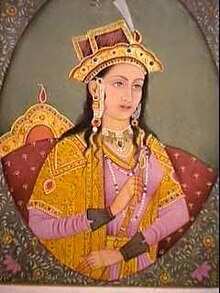Mariam-uz-Zamani: Difference between revisions
m r2.7.3) (Robot: Modifying gu:મરીયામ ઉજ઼-જ઼માનિ |
m Pearz25 moved page Mariam-uz-Zamani to Mariam uz-Zamani |
(No difference)
| |
Revision as of 13:05, 15 July 2012
| Mariam uz-Zamani Begum Sahiba مرہم از-زمانی بیگم صاحبہ | |||||
|---|---|---|---|---|---|
| Mughal Empress | |||||
 Artistic depiction of Mariam uz-Zamani alias Harkha Bai | |||||
| Born | October 1, 1542 Amer | ||||
| Died | 1622 | ||||
| Burial | |||||
| Spouse | Mirza Jalaluddin Mohammed Akbar | ||||
| |||||
| Dynasty | Mughal | ||||
| Father | Raja Bharmal | ||||
| Religion | Hinduism | ||||
Mariam uz-Zamani Begum Sahiba (Other Names: Rukmavati Sahiba, Rajkumari Hira Kunwari and Harkha Bai). was a Rajput princess who became the Mughal Empress, after her marriage to Mughal Emperor Akbar. She was the eldest daughter of Kachwaha Rajput, Raja Bharmal of Amber, the older name of the Rajput State of Jaipur .
Her notability arises from her marriage to the Mughal emperor Akbar the Great. She was also the mother of emperor Jahangir, her husband's heir.
Her name as in Mughal chronicles was Mariam-uz-Zamani. This is why the mosque of Mariyam Zamani Begum was constructed in The Walled City Of Lahore, present day Pakistan, in her honour. Hira Kunwari, Akbar's first Rajput wife, was the eldest daughter of Raja Bhar Mal of Amber.[1] She was also the sister of Bhagwandas and the aunt of Man Singh I of Amber.[2]
The Mosque of Mariyam Zamani Begum was built by her son Nuruddin Salim Jahangir and is situated in the Walled City of Lahore, present day Pakistan, while Mariam's Tomb is situated 1km away from Tomb of Akbar the Great, at Sikandra, near Agra, present day India.
Life
Rajkumari Hira Kunwari was married to Akbar on February 6, 1562, at Sambhar, Rajasthan, India. She was Akbar's third wife and one of his three chief queens. Akbar's first queen was the childless Ruqaiyya Begum, and his second wife was Salima Sultan, the widow of his most trusted general, Bairam Khan. After her marriage, Hira Kunwari was given the title Mariam-uz-Zamani ("Mary of the Age").[3]

She is said to have been politically involved in the court until Nur Jahan became empres
Maryam Zamani owned and oversaw the ships that carried Haj pilgrims to and from the Islamic holy city Mecca. In 1613, her ship, the Rahīmī was seized by Portuguese pirates along with the 600-700 passengers and the cargo. When the Portuguese officially refused to return the ship and the passengers, the outcry at the Moghul court was quite severe. Zamani's son, the Indian emperor Jahangir ordered the seizure of the Portuguese town Daman. This episode is considered to be an example of the struggle for wealth that would later ensue and lead to colonization of the Indian sub-continent.[4]
Maryam Zamani died in 1622.[5] As per her last wishes, a vav or step well was constructed by Jahangir. Her tomb, built in 1611, is on the Tantpur road now known as in Jyoti Nagar. Her tomb is now known as "Jodhabai ki chhatri". She was buried according to Islamic custom. The tomb's location reduced its chances of becoming a tourist attraction, but likewise, its lack of visibility meant it fell into a state of disrepair. However, in the middle of 2010, the Ministry of Culture expressed interest for saving it when news of the tomb's condition spread through media. As a result, the location is now under being managed by the Indian Government.
The misnomer Jodha Bai
There is a popular perception that the Rajput wife of Akbar, mother of Jahangir, was known as "Jodha Bai".[1]
Tuzk-e-Jahangiri, the autobiography of Jahangir, doesn't mention Jodha Bai.[1] Therein, she is referred to as Mariam Zamani.[6] Neither the Akbarnama (a biography of Akbar commissioned by Akbar himself), nor any historical text from the period refer to her as Jodha Bai.[6]
According to Professor Shirin Moosvi, a historian of Aligarh Muslim University, the name "Jodha Bai" was first used to refer to Akbar's wife in the 18th and 19th centuries in historical writings.[6] According to the historian Imtiaz Ahmad, the director of the Khuda Baksh Oriental Public Library in Patna, the name "Jodha" was used for Akbar's wife for the first time by Lieutenant-Colonel James Tod, in his book Annals and Antiquities of Rajasthan.[3]
According to Professor N R Farooqi, a historian of Allahabad Central University, Jodha Bai was not the name of Akbar's Rajput queen; it was the name of Jahangir's Rajput wife Princess Manmati of Jodhpur, whose real name was Jagat Gosain.[1]
References
- ^ a b c d Atul Sethi (2007-06-24). "'Trade, not invasion brought Islam to India'". The Times of India. Retrieved 2008-02-15.
- ^ "Jaipur (Princely State)". Retrieved 2008-02-15.
- ^ a b Syed Firdaus Ashraf (2008-02-05). "Did Jodhabai really exist?". Rediff.com. Retrieved 2008-02-15.
- ^ Findly, Ellison B. (1988). "The Capture of Maryam-uz-Zamānī's Ship: Mughal Women and European Traders". Journal of the American Oriental Society. 108 (2). American Oriental Society: 227–238. doi:10.2307/603650. JSTOR 603650.
- ^ Glynn, Catherine; Smart, Ellen (1997). "A Mughal Icon Re-Examined". Artibus Asiae. 57 (1/2). Artibus Asiae Publishers: 5–15. doi:10.2307/3249948. JSTOR 3249948.
- ^ a b c Ashley D'Mello (2005-12-10). "Fact, myth blend in re-look at Akbar-Jodha Bai". The Times of India. Retrieved 2008-02-15.
